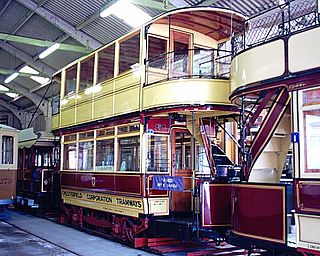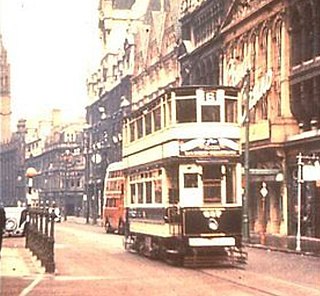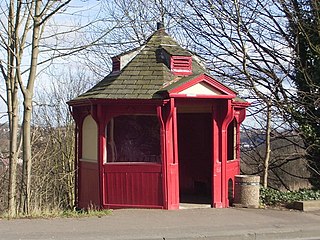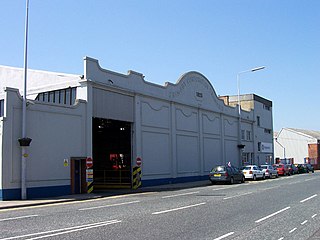The Brisbane Tramway Museum is an Australian transport museum that has preserved a collection of trams and trolleybuses most of which operated in Brisbane from 1897 until 1969. The museum is located at Ferny Grove.

The Sydney tramway network served the inner suburbs of Sydney, Australia, from 1879 until 1961. In its heyday, it was the largest in Australia, the second largest in the Commonwealth of Nations, and one of the largest in the world. The network was heavily worked, with about 1,600 cars in service at any one time at its peak during the 1930s . Patronage peaked in 1945 at 405 million passenger journeys. Its maximum street trackage totalled 291 km in 1923.

The Chesterfield and District Tramways Company and its successors ran a tramway system in the Derbyshire town of Chesterfield, England. The first horse-drawn line opened in 1882, and in 1897, the system was taken over by Chesterfield Corporation, who extended and electrified it in 1904 and 1905. Additional tramcars were purchased, but two had to be scrapped after a disastrous fire at the depot in 1916. The system suffered from a lack of maintenance as a result of reduced staffing levels during the First World War, and the trams were replaced by trolleybuses in 1927.

The Kingston upon Hull tramway network was a network of 4 ft 8+1⁄2 instandard gauge tram lines following the five main roads radially out of the city centre of Kingston upon Hull, East Riding of Yorkshire, England. Two of these lines went west, and two east. The fifth went to the north, and branched to include extra lines serving suburban areas. Additionally a short line linked the city centre to the Corporation Pier where a ferry crossed the Humber Estuary to New Holland, Lincolnshire.

Birmingham Corporation Tramways operated a network of tramways in Birmingham from 1904 until 1953. It was the largest narrow-gauge tramway network in the UK, and was built to a gauge of 3 ft 6 in. It was the fourth largest tramway network in the UK behind London, Glasgow and Manchester.

The earliest trams in Australia operated in the latter decades of the 19th century, hauled by horses or "steam tram motors". At the turn of the 20th century, propulsion almost universally turned to electrification, although cable trams lingered in Melbourne. In cities and towns that had trams, they were a major part of public transport assets.
Edinburgh Corporation Tramways formerly served the City of Edinburgh, Scotland. The city used four-wheeled double-decked trams painted dark red (madder) and white – a livery still used by Lothian Buses and the post-2014 Edinburgh Trams.

Portsmouth Corporation Transport was a tram, trolleybus and bus operator formed in 1898, serving the city of Portsmouth, and owned by Portsmouth Corporation. Tram services ended in 1936, trolleybus services in 1963, while bus operations continued until the company was privatised in 1988.

Trams no longer operate in Hobart, the capital of the Australian state of Tasmania, but the city once had an extensive and popular system that reached the majority of its suburbs. It was the first complete electric tram system in the Southern Hemisphere, and the only one in Australia to operate double-decker trams.

The Perth tramway network served Perth, the capital city of Western Australia, from 1899 until 1958. The network was initially run by a private company but was taken over by the state government in 1913. From a single line along Hay Street, the network expanded north as far as Osborne Park, east as far as Welshpool, south as far as Como, and west as far as Claremont. The tramways were gradually replaced by buses after World War II.
The South Lancashire trolleybus system once served towns in South Lancashire, England, including Atherton, Bolton, Swinton and Leigh and St Helens. Opened on 3 August 1930, it replaced the South Lancashire Tramways network.

The Sydney trolleybus system in New South Wales consisted of two unconnected lines in the Eastern Suburbs and St George areas of Sydney.

Huddersfield Corporation Tramways operated a tramway service in Huddersfield, England, between 1883 and 1940. It initially used steam locomotives pulling unpowered tramcars, but as the system was expanded, a decision was taken to change to electric traction in 1900, and the first electric trams began operating in February 1901. The system was built to the unusual gauge of 4 ft 7+3⁄4 in, in the hope that coal wagon from neighbouring coal tramways, which used that gauge, could be moved around the system. This did not occur, but two coal trams were used to delivered coal to three mills.

The P-class trams were a class of trams operated on the Sydney tram network.

The C-class trams were a class of single bogie end-loading electric trams operated on the Sydney tram network.

The R-class trams were a class of drop-centre saloon car type trams operated on the Sydney tram network.

Leichhardt Bus Depot is a bus depot in the Sydney suburb of Leichhardt operated by Transit Systems.

Ridge Street Tram Depot was part of the Sydney tram network.

The Great Grimsby Street Tramways Company was a tramway serving Grimsby and Cleethorpes in Lincolnshire, England. It was a subsidiary of The Provincial Tramways Company. They opened a horse tramway in 1881, running from the Wheatsheaf Inn in Bargate to the border with Cleethorpes, with a branch along Freeman Street, and extended the line into Cleethorpes in 1887. It followed the trend of many British systems, and was converted to an electric tramway in December 1901. Small extensions were made to the system at both ends, but the basic plan of the system remained the same throughout its life.
The Melbourne tram network began in 1884 with the construction of the Fairfield Horse Tramway. However, the purpose of the line was to increase land prices in the area, and it soon closed during the depression in 1890. The first genuine attempt to construct a tramway network was the construction of the Richmond cable tram line by the Melbourne Tramway & Omnibus Company in 1885. Over the next few years, 16 more cable tram lines were constructed, as well as numerous other horse tramways. The depression of the early 1890s slowed further expansion of the cable network. The first electric tram line was the Box Hill and Doncaster tramway which opened in 1889. This was a pioneering line in what was then the countryside and thus didn't receive much patronage. It closed in 1896. The next attempt at an electric tramway was Victorian Railways' St Kilda to Brighton line, which opened in 1906. Later that year, the North Melbourne Electric Tramway & Lighting Company opened lines to Essendon and Maribyrnong. Many local councils formed their own tramway trusts and built tramways within their own constituency. The most successful of these was the Prahran & Malvern Tramways Trust.

















